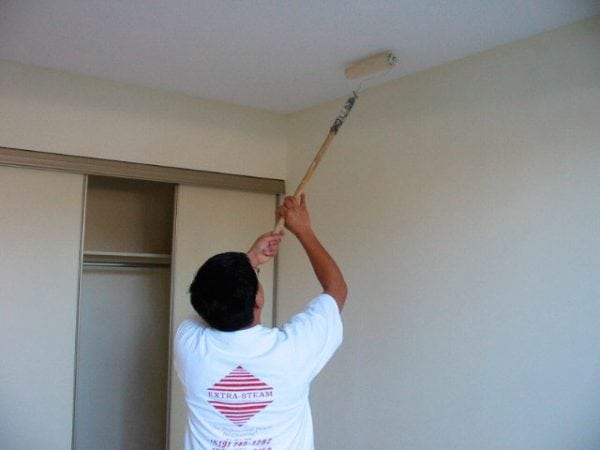If you are not an expert in construction and repair issues, but have undertaken the repair of walls yourself, you will be interested in how to do it right. It is necessary to properly prepare the surface for decoration, select the appropriate materials, observe the sequence of work. For example, walls before whitewashing are usually primed. What materials to use and how to perform work - more on this later.

A primer is a special building material used in intermediate repair work. It performs several tasks:
- providing adhesion of the base elements to each other and with finishing materials;
- extension of the operational term of finishing;
- protective functions: against biological infections, corrosion.
Due to the special composition of the primer, the porosity of the materials used in the arrangement of walls is significantly reduced. The adhesive properties of finishing materials increase. And also the primer is able to hide, level, fix surface defects.
to contents ↑Primer selection
All primers for applying to walls can be divided into two groups: deep-penetrating and strengthening. The materials of the first group are applicable for the treatment of walls made of materials with a loose, porous surface. Such soil can be used indoors and when performing facade finishing works.
The second group of primers is suitable when the surface of the walls has already been processed and preparation for wallpapering, whitewashing, painting.
There are primer mixtures and composition:
- acrylic mixture - the most popular type, suitable for wood, concrete, plastered surfaces (except metal), non-toxic, quick-drying;
- alkyd mixture - recommended for treating wooden surfaces; it is not used for priming gypsum and plaster substrates; it is often used for painting with alkyd solutions, the drying period is up to 15 hours;
- glyptal mixture - can be applied to any metal surface, it is not recommended to use in conditions of high humidity, the drying period is 24 hours;
- polyvinyl acetate mixture - a special composition for further painting with polyvinyl acetate solutions, dries in less than an hour;
- polystyrene mixture - it is possible to work on wood and plaster, it is toxic, therefore it is applicable more for outdoor works;
- perchlorovinyl mixture - applicable for priming metal, concrete, brick and plastered surfaces, has good performance temperatures (including those with a negative value), moderate toxicity, dries in 1-2 hours;
- phenolic mixture - to protect wood and metal, dries within 15 hours.
Under the whitewashing of the mineral base, the primer should be used. It is absorbed into the wall material, forming a strong connection with it.A strong film is formed on the surface, increasing the adhesive properties of mineral materials. After that, the application of any finishing materials is easier and better.

Plasterboard structures must be primed, since without this cardboard will “pull” moisture from whitewash, glue, and putty applied to it, which impairs the adhesion of the finish coating. But primed drywall is deprived of this ability.
Note that the “blocker” works in both directions: that is, an obstacle to the “absorption” of moisture by walls and from walls. This means that the appearance of stains, dark spots or fungal mold after repair does not threaten you, as does the drying of the decorative topcoat.
The waterproof protective film formed due to the soil layer is of yet another great importance - saving the consumption of finishing solutions (wallpaper glue, emulsion, putty, paint, varnish).
By the way, not only walls but also shelves fall under whitewashing. The latter most often gets off that way.
to contents ↑Preparatory work
Before applying the primer, the surface of the base must be properly prepared.
- To clear surfaces of an old decorative covering.
- Wash rust and smudges with water, treat with a solution of copper sulfate.
- Remove greasy stains (hot calcined salt solution).
- The soot is washed off with a solution of hydrochloric acid.
- Connecting seams, cracks, chips and other defects must be puttied.
After this, a primer solution can be applied.
- Dilute the mixture according to the instructions on the label.
- Bring to a homogeneous consistency by thoroughly mixing with a construction mixer.
- You can work with a brush or roller. The solution should be evenly distributed over the entire surface, without the formation of smudges and dry spots.
- After the first treatment, you should take a break. Primer with a second layer is possible after at least 2-3 hours.
Do not immediately dilute the entire volume of the primer mixture. It is better to cook exactly as much as you need for one time, and prepare a fresh portion before the second application. Painting tools between steps should be kept clean. Use personal protective equipment (gloves, headgear, goggles), especially in the case of ceiling decoration.
You can whitewash walls and ceilings with chalk or lime mortar. The substance is applied in at least two layers, moreover, the second - after the first has dried. New paint brushes before whitewashing should be softened by soaking for several hours in water.
Subject to the technology and rules of work, whitewashed surfaces will not require updating for a long period. A high-quality primer will protect against the appearance of such troubles as stains, stains, mold, bloating, exfoliation and so on.




